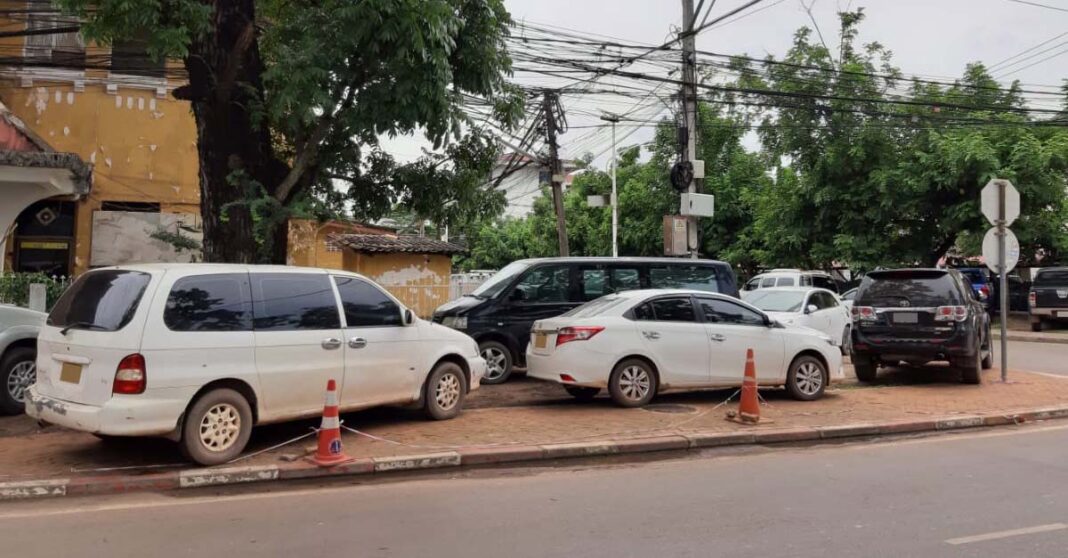Pedestrians in Vientiane Capital are routinely forced to walk into oncoming traffic as they navigate around vehicles parked on the footpath. Despite hundreds of attempts by authorities, the issue has yet to be resolved. But could new technology play a part in solving the problem once and for all?
When cars park in areas not designed to hold their weight, it can erode infrastructure and cause traffic congestion, not to mention placing pedestrians at great risk as they walk on the road amid oncoming traffic.
Police and local authorities in Vientiane have made attempts over and over again to educate motorists and reduce the problem of cars parking on the footpath. However, most attempts have proven ineffective, with the problem quickly appearing following a crackdown.
Although the city’s police try their best, physically attaching clamps to every illegally parked vehicle requires a lot of manpower, and the equipment costs money to maintain.
“We see the cars parked everywhere,” one police officer, who asked to remain anonymous, told Laotian Times.
“It looks so messy, but it is out of our control. For every clamp we own, there are ten more cars,” he said.
But could modern technology offer a solution to developing countries, like Laos, that lack the funding and the manpower?
With a network of CCTV cameras already in place around Vientiane, sophisticated computer technologies and license plate recognition software could analyze parked cars and notify authorities. The owner could be warned, and if the car is not moved, the owner could be fined.
Rather than relying on traditional methods, the fine could be exacted via an online banking system, making use of local technology such as BCEL One or LOCA Pay.
Meanwhile, a mobile application could be connected to the network allowing residents to report illegally parked cars, empowering them to quietly take action when their residence or business is blocked.
Many major cities in the United States and Canada have made use of the “311” mobile application, for example. New York, California, and Toronto have made this app available to their populations, allowing users to report abandoned vehicles or illegally parked cars by selecting a location, adding a description, and uploading a photo of the violation.
A case study on a technological solution was done in Vietnam by To Thuc, a lecturer at James Cook University in Australia. To and his team used mathematical programming software, called MATLAB, to count the number of vehicles parked on the footpaths in Hanoi.
A basic database was easily built by his senior engineering students to show the results of the study. The software was able to detect cars that were parked on the footpath for more than five minutes and detect objects encroaching on the footpath. The result showed that the AI made no errors when identifying objects on footpaths, and only 2% of the plate numbers it read were incorrect.
If successful when applied to a much larger city like Hanoi, then a similar project could conceivably be undertaken to deal with cars parked on the footpaths in Vientiane.
Investment in new technologies such as Artificial Intelligence combined with existing CCTV and mobile phone networks could provide solutions to ongoing problems such as illegally parked vehicles.
The technology would not only reduce the workload of police forces, but also reduce costs for the government, creating a cleaner, safer, and more inviting city for residents and tourists to enjoy.
As To Thuc says, “technological solutions are increasingly bringing us practical benefits and it is our outdated mindsets that have restricted them from developing.”



